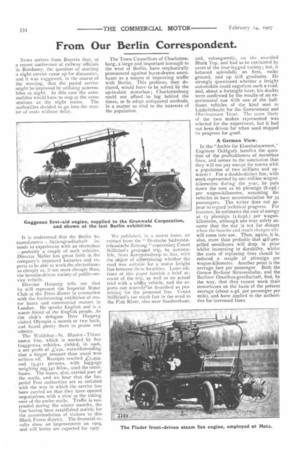From Our Berlin Correspondent.
Page 22

If you've noticed an error in this article please click here to report it so we can fix it.
News arrives from Batavia that, at a recent conference of railway officials in Bandoney, the question of starting a night service catne up for discussion, and it was suggested, in the course of the meeting, that the postal service might be improved by utilising automobiles at night. In this case the automobiles would have to stop at the same stations as the night trains. The authorities decided to go into the matter of costs without delay.
It is underAeod that the Berlin Accumulatoren Aktiengesellschaft intends to experiment with an electrobus —probably a couple of such vehicles. Director Muller has great faith in the company's improved batteries and expects to be able to work the electrobuses as cheaply as, if not more cheaply than, the benzine-driven variety of public-service vehicle.
Director Haspergtells me that 1:e will represent the Imperial Motor Club at the Press dinner in connection with the forthcoming exhibition of nntor boats and commercial motors in London. He speaks English and is a warm friend of the English people. As the club's delegate Herr Hasperg visited Olympia a month or two back, and found plenty there to praise and admire.
The Waldshut St. Blasien -Titisee motor line, which is worked by five Gaggenau vehicles, yielded, in mob, a net profit of £230, notwithstanding that a larger amount than usual was written off. Receipts reached and 15,512 persons, with luggage weighing 295,341 kilos., used the omnibuses. The buses, also, carried part of the mails, and we hear that the Imperial Post authorities are so satisfied with the way in which the service has been carried on that they have opened negotiations with a view to the taking over of the entire mails. Traffic is suspended during the winter months, the line having been established mainly for the accommodation of visitors to this Black Forest district. The financial resuits show an improvement on 1905, and still better are expected for 1907. The Town Councillors of Charbattenburg, a large and important borough to the west of Berlin, have emphatically pronounced against horse-drawn omnibuses as a means of improving traffic with Berlin. This problem, they declared, would have to be solved by the up-to-date motorbus ; Charlottenburg could not afford to tag behind the times, or to adopt antiquated methods, in a matter so vital to the interests of the population.
We published, in a recent issue, ;In extract from the " Deutsche Siidwesta. trikanische Zeitung "concerning Count Stillfried's projeqed trip, by automobile, from Keetrnanshoop to Aus, with the object of ascertaining whether the road was suitable for a motor freight line between these localities. Later editions of this paper furnish a brief account of the trip, as well as an actual trial with a utility vehicle, and the reports can searcely'be described as promising for the proposed line. Count Stillfried's car stuck fast in the sand in the Fish River, also near Sandverhaar, and, subsequently, en the so-called Black Top, and had to be extricated by asses of the four-legged variety ; but, it behaved splendidly on firm, rocky ground, and up stiff gradients. He strongly questioned whether a freight automobile could negotiate such a road, and, about a fortnight later, his doubts were confirmed by the results of an ex. peritnental run with one of the half. dozen vehicles of the kind sent to LUderitzbucht for the Government and Oberleutnant Trost. The more likely of the two makes represented was selected for the experiment, but it had not been driven far when sand stopped its progress for good.
A German View.
In the "Archly fur Eisenbahnwesen, Engineer Oeldguth handles the question of the profitableness of motorbus lines, and comes to the conclusion that they will not pay except for towns with a population of two millions and upwards I For a double-decker line, with work represented by one million wagonkilometres during the year, he puts down the cost as 66 pfennigs (8.25d.) per wagon-kilometre, assuming the vehicles to have accommodation for 34 passengers. The writer does not appear to regard technic-al progress. For instance, he estimates the cost of energy at 13 pfennigs (x.625d.) per wagonkilometre, although one may safely assume that the day is not far distant when the heavier and much cheaper oils will come into use. Then, again, it is, also, more than probable that self-propelled omnibuses will drop in price whilst increasing in durability, whilst the costs of replacing tires should be reduced a couple of pfennigs per wagon-kilometre. Another point is the average fare per passenger. Both the Grosse Berliner Strassenbahn, and the Berliner Omnibus-gesellschaft, find, by the way, that they cannot work their motorbuses on the basis of the preSent average (about o.5d. per passenger per mile), and have applied to the authorities for increased fares.
























